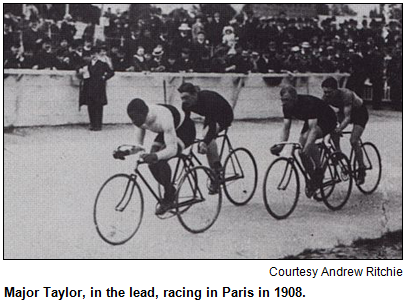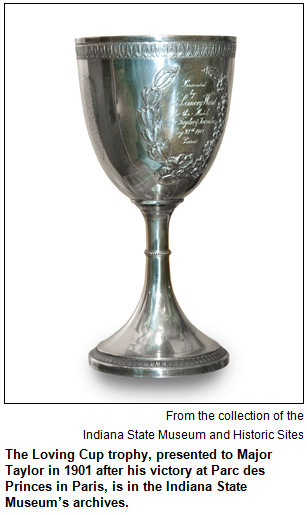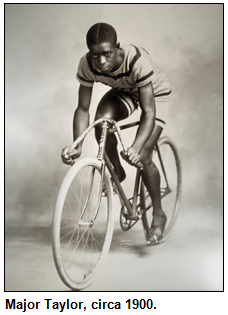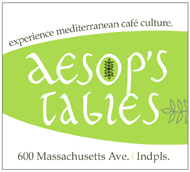Feb. 2 show
Major Taylor, world's greatest bicyclist of early 1900s
Amid the international controversy swirling around Lance Armstrong, Hoosier History Live! will explore the dramatic life of the Indianapolis native who was the world's top bicyclist during the 1890s and early 1900s - and whose amazing victories were accomplished without performance-enhancing drugs.
Even so, Major Taylor (real name: Marshall W. Taylor) coped with a mountain of challenges, including extensive racial prejudice in Indiana and elsewhere.  Despite achieving wealth - and meeting the kings and queens of Europe - Major Taylor (1878-1932) died in poverty and was buried in a grave without a marker.
Despite achieving wealth - and meeting the kings and queens of Europe - Major Taylor (1878-1932) died in poverty and was buried in a grave without a marker.
This show about one of the first African-Amerian athletes to become famous around the world will kick-start our salute to Black History Month.
Nelson will be joined in studio by guests including Kisha Tandy, assistant curator of social history at the Indiana State Museum, which has an extensive collection of Major Taylor artifacts. They include lettters, rare photos, postcards and nine scrapbooks kept during his heyday by family members.
Kisha has been the local escort for Major Taylor's descendants, who live in Massachusetts but have visited sites in Indy connected with their legendary ancestor. Those sites include a historic marker erected on the Monon Trail near East 38th Street, the location of a bygone track where Taylor had been banned after setting a record.
Of course, the best-known Hoosier site named in honor of the former world champion is the Major Taylor Velodrome, a cycling track on Indy's westside. Built for $2.5 million, the velodrome opened in 1982 and helped accelerate belated recognition for Taylor, who died in obscurity in the charity ward of a Chicago hospital.
Our studio guests also will include:
- Judy Keene, an Indy-based editor and writer who, beginning in the 1970s when Major Taylor's triumphs had been forgotten, started writing articles about the athlete who once had been internationally acclaimed. Judy also did local research for California-based author Andrew Ritchie, whose biography Major Taylor: The Extraordinary Career of a Champion Bicycle Rider (Johns Hopkins University Press), helped call belated attention to the cyclist.
- And Keith Cruz, organizer of Indiana Bicycle Polo Cooperative.
Coincidentally, Keith and his family live in a 100-year-old house in the Mapleton-Fall Creek neighborhood of Indy that sits on the site of the bygone Newby Oval, a spectacular track that was said to be matched only by Madison Square Garden in New York City for excellence as a bicycle racing venue. Major Taylor competed at the Newby Oval in 1898, 1899 and 1900.
 Taylor was just 16 when he won his first significant race, in 1895, even though spectators yelled racial slurs as he pedaled the 75 miles from downtown Indy (the route took the cyclists northbound up Massachusetts Avenue) to the Grant County town of Matthews.
Taylor was just 16 when he won his first significant race, in 1895, even though spectators yelled racial slurs as he pedaled the 75 miles from downtown Indy (the route took the cyclists northbound up Massachusetts Avenue) to the Grant County town of Matthews.
During that era, many bicycle tracks in Indiana were open to whites only. Even when Major Taylor was setting world records in other countries, he was not spared from prejudice. Gangs of white cyclists often worked together during races to box him in or force him to wreck. In many American cities on the racing circuit, he had to hunt to find places to eat and sleep.
In addition to exploring Major Taylor's dramatic life, Nelson and his guests also will delve into the Newby Oval and other Hoosier cycling venues and competitions during an era before the ascendancy of the car, when bicycle racing was a wildly popular sport.
The northeast turn of the Newby Oval is now the site of Keith's house. A year-round bicycle commuter, Keith works as a designer and draftsman in the parks and greenway department of BF&S, a civil engineering firm.
Major Taylor, whose father was a Civil War veteran, was born in rural Marion County. (According to foklore, his "Major" nickname derived from his habit, beginning at 13, of wearing a military cap and uniform while performing bicycle tricks on local sidewalks.)
He moved to Massachusetts in 1896, seeking greater opportunities with sponsors and on the bicycle race circuit. Taylor reaped national, then international, fame, competing everywhere from France to Australia and winning the world sprint championship in 1899.
 Throughout his life, Taylor, known as the "Ebony Streak," refused to compete on Sundays because of his promise to his mother to "lead an upright Christian life."
Throughout his life, Taylor, known as the "Ebony Streak," refused to compete on Sundays because of his promise to his mother to "lead an upright Christian life."
Unfortunately, he confronted almost overwhelming problems, particularly once Americans rapidly lost interest in bicycle racing with the popularity of cars. A combination of factors, including bad financial investments and a divorce, left him destitute.
When he died in 1932, Major Taylor was buried in an unmarked pauper's grave in Chicago. (Years later, a bronze tablet was erected in a ceremony organzied by Frank Schwinn of the Schwinn Bicycle Company, who never forgot Taylor's heroics.)
Long before then, the Newby Oval had been torn down. Built on 15 acres near 30th Street and east of Central Avenue, the quarter-mile track had cutting-edge electrical lights and grandstand seats; it regularly drew crowds of nearly 20,000 bicycle racing fans.
But the track's developer, Arthur Newby, eventually joined partners who were car enthusiasts, including Carl Fisher and Jim Allison, to focus on the new Indianapolis Motor Speedway.
Some recommended "learn more" websites:
Roadtrip: Love Your Heart/You Are There 1939: Healing Bodies
With Roadtripper Chris Gahl of Visit Indy out on assignment, our guest Roadtripper will be statuesque Amy Lamb of the Indiana Historical Society. On the heels of Valentine's Day and in celebration of American Heart Month, Amy will tell us about the "Love Your Heart" program on Saturday, Feb. 16, at the Eugene and Marilyn Glick Indiana History Center in downtown Indianapolis. Free admission will be offered to guests, and the day includes presentations and heart-healthy activities.
To learn more about early heart health in Indianapolis, guests will also be able to step back in time with You Are There 1939: Healing Bodies, Changing Minds to learn the story of Dr. Harvey Middleton, a black physician who was one of Indianapolis' early heart specialists.
"Love Your Heart" at IHS is a program of 2013 Indy Talks, which has the theme of Indy's Kids. IHS's daylong program will focus on heart and general health - especially for youths. Other participants will include the JCC with presentations about food choice, and energizing and educational activities will be offered by IUPUI's Schools of Physical Education and Tourism Management. Kroger also will be on hand to offer healthy food samples.
History Mystery
In the three "B" sports that captivated Americans from the 1890s through the 1920s - baseball, bicycle racing and boxing - Indianapolis was the hometown of two African-American superstars. Bicycling champion Major Taylor was the first to attain fame.
The other athlete was a baseball star - a slugger, pitcher and outfielder in the early era of the Negro Leagues who became known as "the black Babe Ruth."
 Beginning in 1915, his rookie year with the Indianapolis ABCs team, he spent 33 seasons playing for or managing various Negro League teams. Several baseball analysts have called him one of the greatest players who ever lived, although his achievements are hard to pin down because early record-keeping in the Negro Leagues was sketchy.
Beginning in 1915, his rookie year with the Indianapolis ABCs team, he spent 33 seasons playing for or managing various Negro League teams. Several baseball analysts have called him one of the greatest players who ever lived, although his achievements are hard to pin down because early record-keeping in the Negro Leagues was sketchy.
After a stellar career as a player, the Indy native became the manager in the 1930s of the Pittsburgh Crawfords, a team considered one of the greatest in Negro Leagues history. Later in life, the former player returned to his hometown to manage the Indianapolis Clowns.
Question: Who was the Indy native who became an early superstar of the Negro Leagues?
To win the prize, you must call in with the correct answer during the live show and be willing to be placed on the air. Please do not call if you have won a prize from any WICR show during the last two months. The call-in number is (317) 788-3314, and please do not call until you hear Nelson pose the question on the air.
This week's prize is two tickets to the James Whitcomb Riley Museum Home and two tickets to the Indiana Experience at the Eugene and Marilyn Glick Indiana History Center. These prizes are courtesy of Visit Indy.
You're invited!
Hoosier History Live! fifth-anniversary party is Feb. 21
Hoosier History Live! has been on the air for five years. Let's celebrate!
When: Thursday, Feb. 21, 5 to 8 p.m.
Where: New location! Indiana Landmarks Center, 1201 N. Central Ave. in Indianapolis.
What: Soft drinks, appetizers and cash bar. Meet and mingle with fellow history lovers. History Mystery Game Show, live from the Cook Theater stage, hosted by Nelson Price. Event is hosted by Indiana Landmarks.
This is a complimentary event; however, if you wish, you are welcome to make a voluntary contribution by using the “Donate" button at the bottom of the RSVP page, or by bringing a voluntary donation to the party. If a donation is not in your budget, we look forward to seeing you in any event!
Click here to RSVP for this event.
Your Hoosier History Live! team,
Nelson Price, host and creative director
Molly Head, producer, (317) 927-9101
Chris Gahl, Roadtripper
Richard Sullivan, webmaster and tech director
Pam Fraizer, graphic designer
Garry Chilluffo, creative consultant
Michele Goodrich, Jed Duvall, grant consultants
Joan Hostetler, photo historian
Dana Waddell, volunteer-at-large
www.hoosierhistorylive.org





Please tell our sponsors that you appreciate their support: Aesop's Tables | Indiana Historical Society | Indiana Landmarks | Lucas Oil | Story Inn.
 Acknowledgments to Print Resources, Monomedia, Indiana Humanities, Visit Indy, WICR-FM, Fraizer Designs, Heritage Photo & Research Services, Derrick Lowhorn and many other individuals and organizations. We are an independently produced program and are self-supporting through organizational sponsorships, grants and through individual tax-deductible contributions through Indiana Humanities. We do not receive any government funding. Visit our website to learn how you can support us financially.
Acknowledgments to Print Resources, Monomedia, Indiana Humanities, Visit Indy, WICR-FM, Fraizer Designs, Heritage Photo & Research Services, Derrick Lowhorn and many other individuals and organizations. We are an independently produced program and are self-supporting through organizational sponsorships, grants and through individual tax-deductible contributions through Indiana Humanities. We do not receive any government funding. Visit our website to learn how you can support us financially.
Feb. 9 show
Long-forgotten man who designed Indy
Finally and at last, the surveyor who traveled to the Indiana wilderness and laid out the state's new capital is getting some respect.
A boutique hotel that just opened in downtown Indianapolis is named in honor of Alexander Ralston. So is a pub-restaurant that opened last year on Massachusetts Avenue, one of the dozens of streets designed by the planner who even had slipped into obscurity by the time he died in 1827.
 Hoosier History Live! not only will explore the unheralded life of the surveyor (Ralston also helped design Washington D.C.) who had such an enormous impact on the Hoosier capital, we also will analyze issues that historians have debated for decades: The reasons Ralston gave various names to specific streets in the new city.
Hoosier History Live! not only will explore the unheralded life of the surveyor (Ralston also helped design Washington D.C.) who had such an enormous impact on the Hoosier capital, we also will analyze issues that historians have debated for decades: The reasons Ralston gave various names to specific streets in the new city.
For this show about Ralston (1771-1827), Nelson will be joined in studio by Ratio Architects founder Bill Browne, who has delved into the pioneer surveyor's street-naming process. Other guests will be Indianapolis historian Sheryl Vanderstel and Joan Hostetler, co-owner of Heritage Photo & Research Services, both of whom have researched Ralston's colorful life.
A Scottish expatriate, Ralston was an assistant to French architect Pierre L'Enfant when he laid out the nation's capital. But Ralston came to the "west" - the Indiana frontier - at least partially because he was linked to controversial politico Aaron Burr. With surveyor Elias Pym Fordham, Ralston was hired to design the new state capital that was created in marsh and swampland during the 1820s.
Foe nearly 200 years, though, virtually nothing in Indianapolis was named in his honor, although some Hoosiers advocated naming I-465 for Ralston.
Now, though, he is becoming "a bit of a rock star," as Urban Times editor Bill Brooks put it in a recent column in the monthly newspaper that serves Indy's historic neighborhoods.
The Alexander, the boutique hotel (with extensive, urban artwork) that recently opened as part of the large CityWay development on the south end of downtown, is named in tribute to Indy's initial designer. (The hotel's bar, Plat 99, takes its name from the site's location on his numbering system.) And Ralston Draft House on Massachusetts Avenue also is named in honor of the long-unheralded city designer.
In addition to sharing his insights into Ralston's street-naming process on our show, our guest Bill Browne, who is board chairman of the Indiana State Museum, will share his conclusions in an upcoming article in Traces of Indiana and Midwestern History, the magazine published by the Indiana Historical Society.
Our guest Sheryl Vanderstel researched and wrote the Encyclopedia of Indianapolis (Indiana University Press, 1994) entries for Ralston, who planned Indy's original Mile Square plat, as well as for surveyor Fordham. Our guest Joan Hostetler, who specializes in local historic research and in preserving, digitizing and archiving historic photos, collaborated with Nelson and photographer Garry Chilluffo on the Indianapolis Then and Now (Thunder Bay Press, 2004) visual history book.
© 2013 Hoosier History Live! All rights reserved.